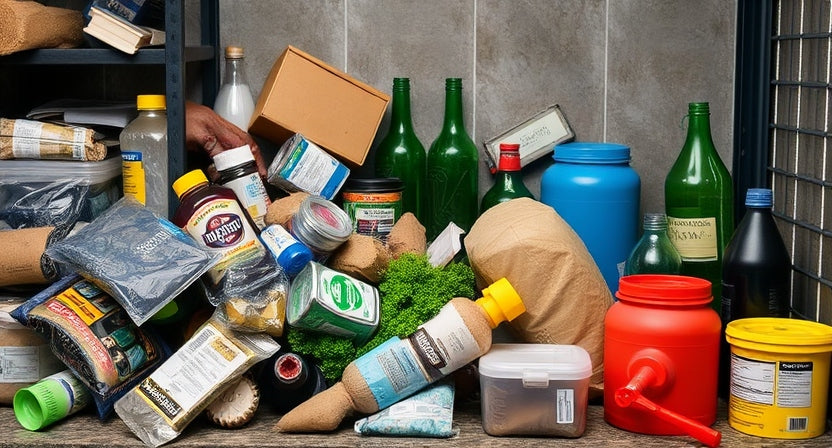A feature wall can instantly make a living room feel more intentional, adding depth and character without a full renovation. The key is choosing the right surface (often the wall behind the sofa, fireplace, or TV), then matching colour, texture, and lighting to the way you actually use the space. Deep blues, greens, and charcoals create a cosy, evening-friendly mood, while warmer terracottas and ochres bring energy for social rooms. If paint feels too simple, wallpaper, slatted panelling, or subtle texture can deliver impact without overwhelming the rest of your décor. Keep sight lines in mind, avoid walls broken up by doors and windows, and test samples across morning, afternoon, and lamp light before committing. At Friendly Turtle EcoBlog, we love home updates that look great and last: thoughtful choices, quality finishes, and flexible styling that won’t date after one season.
Share your articles with us and get published! Reach out at hello@friendlyturtle.com.
How Safe Storage Solutions Can Protect the Environment

If we want to protect the environment, we all have our work cut out.
Between household rubbish, emissions from vehicles like cars, buses and trucks, and the creation of hazardous and solid waste from the manufacturing and industrial businesses, it seems like we are fighting a losing battle to protect Mother Earth.
Indeed, findings from the Department of Agriculture, Water, and the Environment revealed that instead of reducing levels of hazardous waste, Australia is actually increasing them year on year. In fact, it’s even growing at a faster rate than the nation’s population!
While this increase has the potential to do significant damage to the environment, there are some measures we can take to reduce and eventually prevent the damage from happening in the first place.
One such strategy is to embrace safe storage solutions throughout our homes and businesses. Here are six ways we can do that.
1- Reducing Waste through Proper Storage
Reducing our waste levels is arguably the best way to protect the environment from potential damage.
If items like electronics, chemicals, and sensitive materials are not stored properly, they could deteriorate or get damaged more prematurely than they ordinarily would. As a result, they would invariably be disposed of earlier and, therefore, end up in landfills quicker.
For this reason, adopting secure, climate-controlled storage can prolong the lifespan of items. The longer we use the items we already have, the fewer resources are required to manufacture new products.
One way to do this is to store seasonal items like clothes, Christmas decorations or outdoor equipment in a safe environment. Storage providers like WheeKeep highlight how well-designed storage units not only keep your belongings safe but also extend their lifespan, reducing the need for replacements and cutting down on waste. can prevent wear and tear caused by temperature fluctuations, dampness, or pests.
2- Safe Storage for Hazardous Materials
If you don’t handle and storage of hazardous materials, such as chemicals, paints, and cleaning agents, properly, it can have dire consequences for both humans and the planet. Should these substances leak into the soil and waterways, they could cause significant contamination and pose a very real threat to wildlife and ecosystems.
Specialised storage units designed for hazardous materials, like bunded storage solutions can go a long way towards preventing dangerous leaks and spills from happening.
They, and other similar storage solutions, offer features such as spill containment, fireproofing, and ventilation. As a result, they ensure that these materials are stored safely in a way that reduces their overall environmental impact.

3- Preserving Resources with Reusable Storage
Over 95% of plastic packaging is discarded after a single use. Moreover, an astonishing 8 million tonnes of plastic ends up in the world’s oceans every year.
Just by choosing reusable, durable storage containers that are made from sustainable materials can drastically reduce the amount of single-use plastics and cardboard we consume. So, consider switching to recycled plastic, bamboo, or metal options to reduce your carbon footprint.
In addition, many businesses are starting to adopt modular storage systems that can be easily reconfigured and reused over time. This admirable strategy ensures that storage units are not discarded after a single use, and therefore, resources can be conserved.
4- Energy Efficient Storage Facilities
In the past, most storage facilities were guilty of churning up energy through practices like leaving on in-efficient air conditioning systems or lights 24 hours a day. However, increasingly, many are becoming much more eco-friendly by investing in energy-efficient technologies.
Some of these include LED lighting that uses less power than traditional bulbs, solar-powered energy systems that reduce the facility’s carbon footprint and motion sensors that turn off lights when no one is around, thus saving electricity.
Subsequently, if you choose to store your goods in energy-efficient facilities, both the business and you can reduce greenhouse gas emissions and energy consumption.
5- Encouraging Sustainable Practices
Embracing energy-efficient storage solutions as a business is a good starting point. However, some companies are going a step further by incorporating eco-friendly policies that promote sustainable practices into their operations.
For instance, some facilities offer recycling programs for materials like cardboard boxes. At the same time, others have policies in place to minimise paper use by switching to digital documentation.
In addition, encouraging their customers to recycle or donate unwanted items instead of discarding them is another way businesses can help to create a movement of practices that reduce environmental harm.
6- Local storage
Instead of having items stored in a centralised or faraway location, which requires significant amounts of travel and fuel consumption, businesses can reduce the environmental impact of this transportation and fulfilment by adopting local storage solutions.
Ultimately, reducing the need for frequent transportation will help businesses reduce their costs and emissions.
0 comments
Let customers speak for us
Blog posts
Good oral health starts long before the first wobbly tooth. When children learn simple routines early, they’re far more likely to avoid cavities, gum irritation and the stress of emergency appointments later on. Begin with regular dental check-ups so small issues are spotted quickly and visits feel normal, not scary. At home, let your child choose a toothbrush they actually like, then guide them through gentle circular brushing for two minutes, twice a day. Add flossing as soon as teeth touch, and keep it upbeat with a short story or a timer song. For a more planet-friendly routine, pick durable brushes (or responsibly sourced bamboo), turn off the tap while brushing, and choose refillable or recyclable packaging where possible. Friendly Turtle EcoBlog shares practical, low-waste lifestyle ideas like these, helping families build habits that protect little smiles while treading lighter on the Earth.
Preventive care is one of the kindest, most sustainable choices you can make for your pet. Many health problems start quietly: a little plaque, a mild itch from parasites, a gradual dip in energy, or stiffness that only shows up after rest. Left alone, these “small” issues can build into painful dental disease, weight-related strain on joints, or conditions that affect the heart, lungs, liver, or kidneys. In this Friendly Turtle EcoBlog guide, we share practical habits that protect pets over time, from parasite control and lifestyle-led vaccinations to age-appropriate nutrition, daily movement, and simple grooming checks that spot changes early. Consistent routines also matter more than most owners realise, helping you notice subtle shifts before they become expensive emergencies. The goal is not perfection, but steady, evidence-led care that keeps your companion comfortable, active, and thriving for longer.



